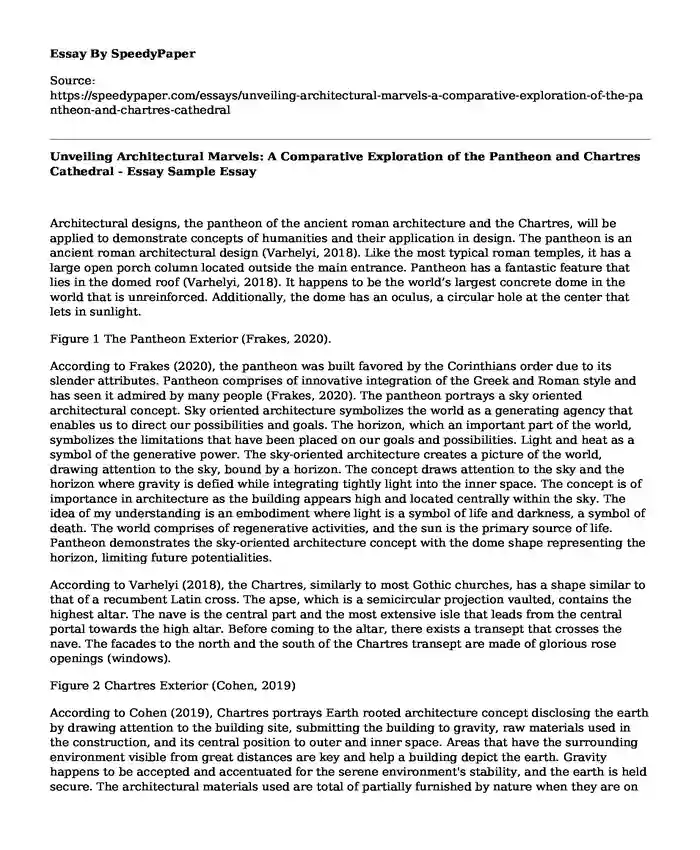
| Type of paper: | Essay |
| Categories: | Architecture |
| Pages: | 3 |
| Wordcount: | 672 words |
Architectural designs, the pantheon of the ancient roman architecture and the Chartres, will be applied to demonstrate concepts of humanities and their application in design. The pantheon is an ancient roman architectural design (Varhelyi, 2018). Like the most typical roman temples, it has a large open porch column located outside the main entrance. Pantheon has a fantastic feature that lies in the domed roof (Varhelyi, 2018). It happens to be the world’s largest concrete dome in the world that is unreinforced. Additionally, the dome has an oculus, a circular hole at the center that lets in sunlight.
Figure 1 The Pantheon Exterior (Frakes, 2020).
According to Frakes (2020), the pantheon was built favored by the Corinthians order due to its slender attributes. Pantheon comprises of innovative integration of the Greek and Roman style and has seen it admired by many people (Frakes, 2020). The pantheon portrays a sky oriented architectural concept. Sky oriented architecture symbolizes the world as a generating agency that enables us to direct our possibilities and goals. The horizon, which an important part of the world, symbolizes the limitations that have been placed on our goals and possibilities. Light and heat as a symbol of the generative power. The sky-oriented architecture creates a picture of the world, drawing attention to the sky, bound by a horizon. The concept draws attention to the sky and the horizon where gravity is defied while integrating tightly light into the inner space. The concept is of importance in architecture as the building appears high and located centrally within the sky. The idea of my understanding is an embodiment where light is a symbol of life and darkness, a symbol of death. The world comprises of regenerative activities, and the sun is the primary source of life. Pantheon demonstrates the sky-oriented architecture concept with the dome shape representing the horizon, limiting future potentialities.
According to Varhelyi (2018), the Chartres, similarly to most Gothic churches, has a shape similar to that of a recumbent Latin cross. The apse, which is a semicircular projection vaulted, contains the highest altar. The nave is the central part and the most extensive isle that leads from the central portal towards the high altar. Before coming to the altar, there exists a transept that crosses the nave. The facades to the north and the south of the Chartres transept are made of glorious rose openings (windows).
Figure 2 Chartres Exterior (Cohen, 2019)
According to Cohen (2019), Chartres portrays Earth rooted architecture concept disclosing the earth by drawing attention to the building site, submitting the building to gravity, raw materials used in the construction, and its central position to outer and inner space. Areas that have the surrounding environment visible from great distances are key and help a building depict the earth. Gravity happens to be accepted and accentuated for the serene environment's stability, and the earth is held secure. The architectural materials used are total of partially furnished by nature when they are on the site. They stand to depict the beauty of the earth. Chartres site has an acropolis, a natural center that dominates the entire concave shape (Cohen, 2019). The interpretation based on the earth rooted concept is that earth is the mother and the foundation of everything from birth to death. Despite everything that exists, the earth has all the resources a security symbol. Besides, the earth encloses darkness, which suggests the earth to be a mystery. To my understanding, the earth-rooted architecture concept connects to Chartres cathedral in that it is founded on the earth rich resources, and the building acts as a natural symbol.
References
Cohen, M. (2019). Understanding the restoration at Chartres 1. The Long Lives of Medieval Art and Architecture, 281-296. https://doi.org/10.4324/9781351181129-17
Frakes, J. F. (2020). Ancient architecture and urbanism in Western Europe (pre-Roman, Roman). Architecture, Planning, and Preservation. https://doi.org/10.1093/obo/9780190922467-0037
Varhelyi, Z. (2018). Jörg Rüpke's »Pantheon«: A comprehensive history of lived religion in Ancient Rome. Religion in the Roman Empire, 4(1), 127. https://doi.org/10.1628/rre-2018-0011
Cite this page
Unveiling Architectural Marvels: A Comparative Exploration of the Pantheon and Chartres Cathedral - Essay Sample. (2023, Dec 16). Retrieved from https://speedypaper.com/essays/unveiling-architectural-marvels-a-comparative-exploration-of-the-pantheon-and-chartres-cathedral
Request Removal
If you are the original author of this essay and no longer wish to have it published on the SpeedyPaper website, please click below to request its removal:
- Free Essay on The Oak Ridges Moraine
- Free Essay: The Biology of Belief Book Analysis
- Free Essay on Sendai Mediatheque by Toyo Ito
- California Electorate Essay Sample
- Essay Sample on Sex Difference and Gender
- Mycobacterium Marinum. Free Essay Example
- Allopatric and Sympatric Speciation - Paper Example
Popular categories




